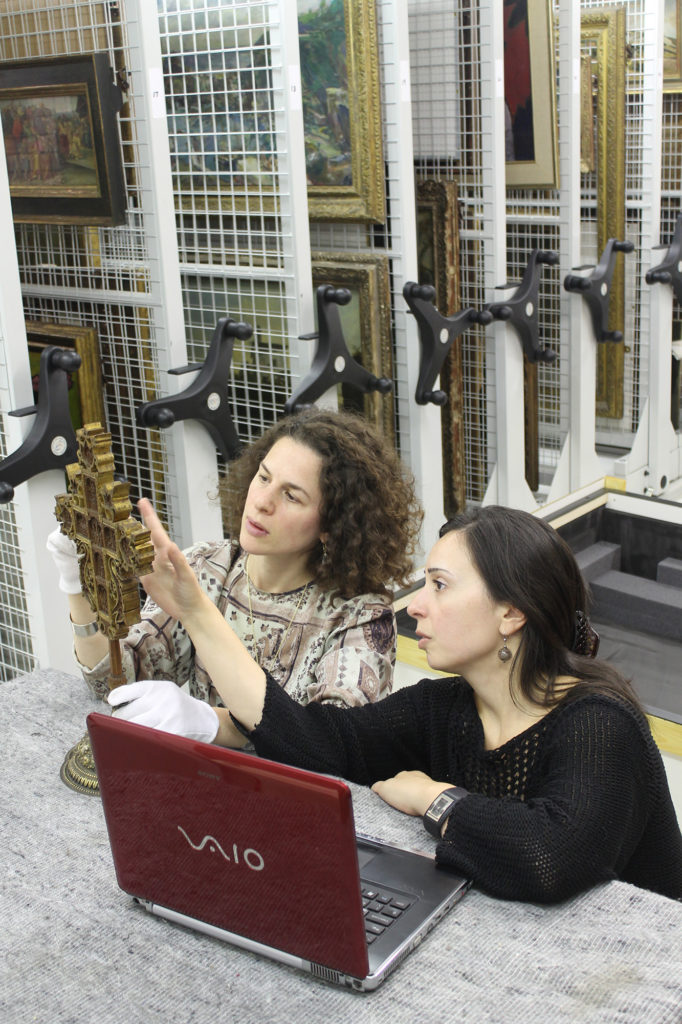Posted on 30 October 2012 by Dr Eleni Dimitriadou.
Illuminating Objects is a new series of displays that shines a light on unexpected objects from the decorative arts and sculpture collection. All these objects have interesting stories to tell, but have rarely been shown and are unknown to all but the most specialist scholars.
The first object we have chosen is an exquisitely carved Orthodox cross.
The Mount Athos Cross
This cross was made in one of the monasteries on Mount Athos in the 17th or 18th century.
For centuries this complex of twenty monasteries was a centre of miniature wood carving, a craft still practised by the monks there today.
This cross was originally used for the benediction of the congregation during the liturgy. It, along with two others, was bequeathed to The Courtauld Gallery in 1966.
Over the last 46 years it has been looked after by the respective curators of Sculpture and Decorative Arts.
It goes on display to the public for the first time today.
Over the last six months I’ve been working with Dr Alexandra Gerstein, Curator of Sculpture and Decorative Arts, on the research and display of this first Illuminating Object.
Working so closely on a single object is not as straightforward as you might think, especially when dealing with a piece as intricate as this cross.
It’s been an interesting challenge to try and communicate the complexity and purpose of the cross’ decoration and place it in its cultural context.
The very first task was to choose which one of the three carved wooden crosses of the collection we were going to display.
Making a decision was not easy – but in the end the size of this cross (it’s the largest of the group) and more importantly the quality of carving dictated our choice.
Both sides of the cross are covered in intricately carved miniature scenes.
These scenes are from the Great Feasts cycle, known as Dodekaorton in Greek, essentially events from the life of Christ and the Virgin.
Foliate ornaments around the cross are carved with Old Testament narratives, prophets and saints.
On the lateral sides of the cross are two acronyms, referring to the salvation of mankind through sacrifice.
We wanted to make sure all of these details are visible to visitors, so we’ve placed the cross in a freestanding case.
Our next challenge was to work out how orientate the viewer through all 18 scenes, not to mention the singular images of prophets and saints.

We suggest following a chronological order, starting from the scene of the Annunciation on Side A and working your way down to the Raising of Lazarus and then to Side B.
This is not, however, the only way of looking at it.
What is important to understand about this cross is that the choice of placing specific Old Testament events around certain New Testament scenes is not coincidental – they interact to emphasise the salvation of mankind, a profound human concern for thousands of years.
Working on this project alongside the curator has given me real insight into the process of organising exhibitions.
It’s also meant that I’ve become aware of a group of artworks – carved wooden crosses – which have attracted very little scholarly attention. I’m intending to do further research on the subject culminating in an academic article.
Finally, I would like to thank Klairi Angelou for compiling documentation on the crosses for the object files.
The Mount Athos Cross was on display from 30 October 2012 – 4 February 2013.
Dr Eleni Dimitriadou, Visiting Lecturer at The Courtauld Institute of Art


